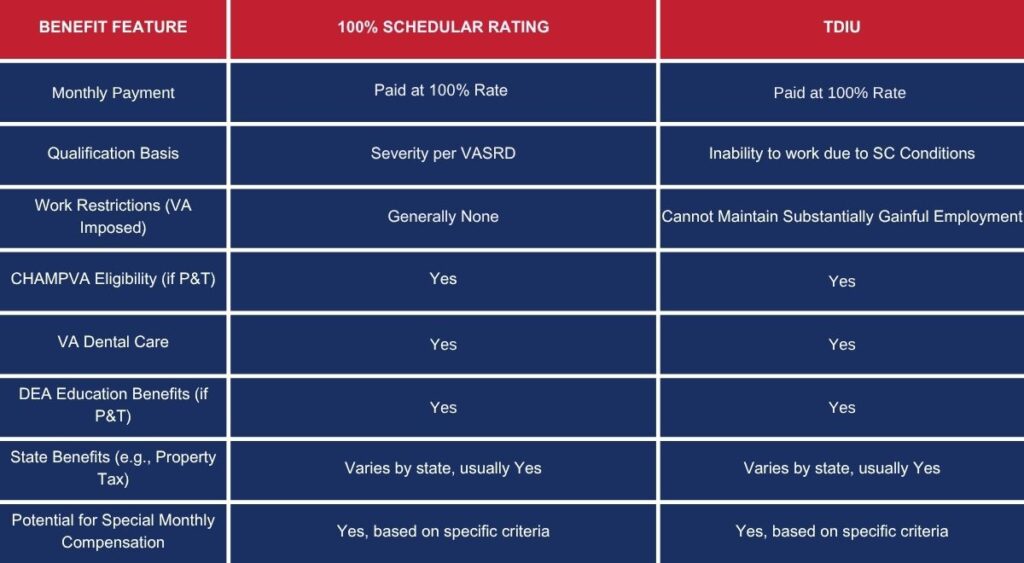
Trying to figure out the difference between VA disability ratings can feel like reading a different language. You hear terms thrown around like 100% P&T, schedular ratings, and TDIU, and it’s easy to get lost. Today, we’re clearing up the confusion surrounding two big ones: Understanding VA Individual Unemployability (TDIU) vs. 100% Disability Rating.
Knowing how these two paths work is important for getting the benefits you earned through your service. They might sound similar, especially since both can pay at the 100% rate, but how you get there and what it means for things like working are quite different. We’ll break down what each one is, who qualifies, and what you should think about when considering your own situation related to your VA disability claim.

What Exactly is a 100% Schedular VA Disability Rating?
Let’s start with the 100% schedular rating. This is probably what most people think of when they hear “100% disabled veteran.” It means the Department of Veterans Affairs (VA) has determined, based on their official rating schedule, that your service-connected disabilities combine to a 100% level using their calculation methods.
The VA uses a specific set of criteria, found in the VA Schedule for Rating Disabilities (VASRD), to assign a percentage rating to each service-connected condition. These percentages reflect the average impairment in earning capacity caused by the disability. Getting to 100% isn’t simple addition; the VA uses a method often called “VA math” to combine multiple disability ratings.
Think of it like starting with 100% efficiency and subtracting the percentage for your most severe disability. Then, take the next percentage from the remaining efficiency, and so on. This method means combining multiple lower ratings doesn’t always straightforwardly add up to 100%; reaching that 100% VA disability rating often requires several significant conditions.
Receiving a 100% schedular rating generally means you have one or more very severe service-connected disabilities, or a combination of conditions, that significantly impact your health. This VA rating isn’t directly tied to your ability to work, although severe disabilities often do affect employment. It’s based purely on the medical severity according to the VA’s rating rules for disability ratings.
So, What is VA Total Disability based on Individual Unemployability (TDIU)?
TDIU stands for Total Disability based on Individual Unemployability. It’s a different pathway for veterans to get monthly compensation at the 100% level, even if their combined schedular disability rating is less than 100%. This offers significant TDIU benefits for qualifying disabled veterans.
The core idea behind total disability individual unemployability is recognizing that certain service-connected disabilities, even if not rated at 100%, can prevent a veteran from keeping a steady job. The VA created TDIU because the rating schedule might not always capture the real-world impact a disability individual’s unemployability situation regarding earning a living. It bridges the gap for veterans who are unable to maintain what the VA calls “substantially gainful employment“ due to their service-connected conditions, which might stem from experiences like Agent Orange exposure or burn pit-related issues.
Essentially, if your service-connected disabilities stop you from working, you might qualify for TDIU, sometimes referred to as VA unemployability. If approved, the veteran receives payment at the same rate as a veteran who has a 100% schedular rating. It’s an important benefit administered by the Veterans Affairs for those whose conditions truly prevent them from working.
Understanding VA Individual Unemployability (TDIU) vs. 100% Disability Rating: The Core Differences
Now let’s put them side-by-side. The biggest difference lies in how you qualify for the benefit. A 100% schedular rating depends solely on the severity of your disabilities as defined in the VA’s rating schedule.
TDIU, conversely, hinges on whether your service-connected disabilities prevent you from securing and keeping substantially gainful employment. You don’t necessarily need disabilities rated at 100% combined, but you do need to show work limitations directly caused by those service-connected issues, like a ptsd claim or sleep apnea. This focus on unemployability, the disability individual aspect, is what sets TDIU apart.
Another key difference involves the disability rating thresholds needed. For a 100% schedular rating, your combined rating (using VA math) must reach 100%. For TDIU under the usual schedular rules, you generally need either one service-connected disability rated at least 60%, OR multiple disabilities with a combined rating of 70% or more, with at least one disability rated at 40% or more.
While both result in payment at the 100% rate, the implications for working are vastly different. Veterans with TDIU generally cannot maintain substantially gainful employment. Veterans with a 100% schedular rating usually don’t face the same VA-imposed work restrictions, although their disabilities might practically limit work anyway.
Payment Levels: Is There a Difference?

This is a common point of confusion regarding VA disability claims. Both a 100% schedular rating and an approved TDIU claim result in the veteran receiving VA disability compensation at the 100% rate. The monthly payment amount is identical.
So, from a purely financial compensation standpoint each month, there isn’t a difference between the two once granted. The VA publishes its compensation rates annually, and the amount for 100% applies whether you got there via the schedule or via TDIU benefits. This aims to provide adequate support for veterans whose conditions prevent work.
Remember, though, how you got there (schedular vs. TDIU) can affect other things, like future reviews and especially your ability to work. Additionally, some veterans may qualify for Special Monthly Compensation (SMC) on top of the 100% rate for specific severe circumstances, regardless of how they reached 100%.
Work Restrictions: A Major Distinction
The most significant practical difference often comes down to working. TDIU is specifically awarded because a veteran cannot maintain substantially gainful employment due to service-connected conditions. Therefore, maintaining such employment can jeopardize your total disability individual unemployability status.
What does “substantially gainful employment” mean? Generally, it’s work that pays above the federal poverty level for a single person, as defined annually. Working odd jobs or very part-time (marginal employment) might be allowed, but earning income above the poverty level usually is not compatible with TDIU.
A 100% schedular rating, on the other hand, doesn’t automatically come with VA work restrictions. While the severity of the disabilities might make working difficult or impossible, the VA doesn’t impose an earnings limit simply because you have a 100% schedular rating. You could potentially work and earn any amount without impacting your 100% schedular benefits, unless your work activity contradicts the severity of your rated disabilities, which could trigger a review of your VA disability rating.
How Do You Qualify for TDIU?
Getting TDIU means meeting specific criteria set by the Veterans Affairs. There are two main ways to qualify for this disability claim: schedular and extraschedular.
The standard way, or schedular basis, requires meeting those percentage thresholds we mentioned earlier. You need either one service-connected disability rated at 60% or higher, or multiple service-connected disabilities with a combined rating of 70% or higher (using VA math), with at least one of those conditions rated at 40% or higher. Examples might include severe post-traumatic stress disorder (PTSD) or debilitating effects from Agent Orange exposure.
If you meet these rating requirements, you also need to prove that your service-connected disabilities prevent you from performing substantially gainful employment. This usually involves submitting evidence like medical records detailing your limitations, statements from doctors, and your work history. You’ll typically need to complete VA Form 21-8940, Veteran’s Application for Increased Compensation Based on Unemployability, which is a specific VA form for this benefit.
What if you don’t meet the percentage thresholds but still can’t work due to service-connected conditions? You might still qualify for TDIU on an extraschedular basis. This is less common and typically requires showing your situation is exceptional and that the standard rating schedule doesn’t adequately reflect your level of impairment impacting your ability to secure gainful employment.
Evidence is critical for any TDIU VA claim. You need medical evidence showing the severity and impact of your conditions, plus evidence relating to your inability to work. Lay statements from you, family, or former employers can also be very helpful in supporting your disability individual unemployability case.
How Do You Qualify for a 100% Schedular Rating?

Achieving a 100% schedular rating works differently; it’s based on being disability rated at the highest level according to the VA’s criteria. It’s all about matching the severity of your documented service-connected conditions to the criteria laid out in the VASRD. It’s not directly about whether you can work, but about the level of disability recognized by the VA’s own schedule.
You can reach 100% in a few ways. You might have a single disability that is so severe it warrants a 100% rating on its own (like certain active cancers, specific traumatic brain injuries, or loss of limbs). Or, you might have multiple service-connected disabilities, potentially including mental health conditions like severe post-traumatic stress or conditions like sleep apnea aggravated by service, that combine to 100% using VA math.
Again, VA math isn’t simple addition. For example, two 50% ratings don’t equal 100%. Using the VA’s combined ratings table, two 50% ratings combine to 75%, which rounds up to an 80% overall VA rating.
To get a 100% schedular rating, you need strong medical evidence. This includes diagnoses, treatment records, and importantly, medical opinions that clearly describe how severe your symptoms are and how they match the criteria for higher ratings within the VASRD for each specific condition. Linking your current severity back to your service connection is always fundamental for your VA disability claims.
Comparing the Associated Benefits
Beyond the monthly compensation paid at the 100% rate, both TDIU and a 100% schedular rating often open doors to similar additional benefits. Understanding these ancillary va health and care services can be just as important as the monetary payment.
One major benefit is eligibility for CHAMPVA health care coverage for eligible dependents (spouses and children). This program helps cover healthcare costs for families of veterans who are permanently and totally disabled or died from service-connected conditions. Both TDIU recipients and 100% schedular-rated veterans generally qualify their dependents for CHAMPVA, assuming the veteran is considered permanently disabled (P&T).
Comprehensive VA dental care is another significant benefit. While most veterans enrolled in VA healthcare have limitations on dental coverage, those rated 100% disabled or receiving TDIU typically qualify for extensive or complete dental care through the VA. This access to VA health care services is a substantial advantage.
Dependents may also qualify for education benefits under the Survivors’ and Dependents’ Educational Assistance (DEA) program. This program offers help with tuition and training costs. Again, this generally applies to dependents of veterans rated permanently and totally disabled, which often includes both 100% schedular and TDIU veterans, allowing access to valuable ultimate guides for education planning.
Many states also offer property tax exemptions or reductions for veterans with a 100% disability rating or receiving TDIU. These vary greatly by state, so you’ll need to check with your local state or county veteran services office for details specific to where you live regarding property tax relief.
It’s worth noting the concept of “Permanent and Total” (P&T) disability status. P&T status means the VA considers your total disability level unlikely to improve. P&T can be granted with either a 100% schedular rating or TDIU and secures certain benefits long-term, reducing future VA examinations. Not all 100% or TDIU ratings are automatically P&T, but it’s often granted concurrently or shortly after, especially if the underlying conditions are static or worsening.
Here’s a quick comparison table:

Digging Deeper: Can You Work with TDIU?
We touched on this, but let’s be clear. The purpose of total disability individual unemployability is to help veterans who cannot work due to their service-connected disabilities. So, working a regular, full-time job that pays a living wage is generally not allowed if you’re receiving TDIU benefits.
The VA defines the limit using the term “substantially gainful employment.” This usually means employment that provides annual income above the federal poverty level for one person. If you earn more than this amount, the VA may decide you are capable of substantially gainful employment and could potentially terminate your TDIU benefits, requiring you to navigate the appeals process.
However, there’s an important exception: “marginal employment.” Veterans receiving TDIU can sometimes engage in marginal employment without affecting their benefits. Marginal employment typically means earning below the poverty threshold or working in a protected environment, like a family business or sheltered workshop (perhaps supported by organizations like Soldiers Angels), where accommodations are made that wouldn’t exist in a competitive work setting. It’s crucial for disabled veterans to understand these nuances and report any work income to the VA, possibly through their payment portal or designated forms.
What About Working with a 100% Schedular Rating?
For veterans with a 100% schedular rating based on the VASRD criteria, the situation regarding work is different. There are generally no VA-imposed income limits tied directly to a 100% schedular rating itself, allowing more flexibility for those able to work despite their high disability rating.
This means a veteran rated at 100% based on the severity of their conditions could theoretically hold a job and earn any amount of income without it automatically affecting their VA disability payments. The rating reflects the level of disability, not necessarily the inability to work, even though severe disabilities often do limit employment options significantly for many veterans facing challenges related to post-traumatic stress disorder or other conditions.
One potential caveat: if a veteran’s work activity seems to contradict the severity of their rated conditions (for example, doing heavy manual labor while rated 100% for severe back problems), it could potentially trigger a review by the VA. But, there isn’t a specific income ceiling like there is with TDIU’s substantially gainful employment rule. This distinction is central to veterans law regarding these benefits.
Making the Choice: Which Path Makes Sense for You?
Deciding whether to pursue TDIU or focus on increasing ratings towards a 100% schedular evaluation depends entirely on your individual circumstances. The primary factor is often your ability, or inability, to work due to your service-connected disability.
If your service-connected disabilities genuinely prevent you from working and earning a living wage, and you meet the rating criteria (or might qualify for extraschedular consideration), TDIU could be the right path. It acknowledges your inability to work and provides the compensation needed, though be prepared for the work restrictions involved. Developing a clear road map for your claim is helpful.
If you are still able to work, even with significant disabilities, pursuing increased ratings towards a 100% schedular rating might be more appropriate. This path focuses purely on the medical severity of your conditions according to the VA’s schedule and doesn’t carry the same employment limitations as TDIU. It reflects your level of impairment without restricting potential earnings.
Consider your current disability ratings, the nature of your conditions (e.g., effects of Agent Orange, burn pit exposure, mental health issues, stress disorder), your prognosis for improvement (or worsening), and your employment situation. It can be a complex calculation involving disability law principles, and sometimes the best path isn’t immediately obvious, potentially requiring evaluation of the appeals process if one route is unsuccessful.
Getting Help with Your VA Claim
Trying to sort through VA rules, rating schedules, and forms like the TDIU application can feel overwhelming. You served your country, and understanding the VA system shouldn’t be another battle fought alone. That’s where expert help, potentially from resources familiar with veterans law like Berry Law or other qualified representatives, can make a real difference.
At Vet Claim Solutions, we understand the details of both TDIU and 100% schedular ratings. We’ve helped countless veterans figure out which option aligns best with their situation, offering support similar to initiatives focused on veterans suicide prevention by reducing stress. We work with you to understand your conditions and how they impact your life and ability to work, providing a potential free case evaluation.
Our team can assist in gathering the necessary medical evidence, employment history documentation, and lay statements needed to build a strong case for your va disability claim. We help make sure your application accurately reflects your level of disability or your inability to work, depending on the path you’re pursuing for commonly approved va claims or more complex ones. We focus on presenting your disability claim clearly and effectively to the VA, acting as a guide similar to how organizations hire veterans or support initiatives like Soldiers Angels.
Whether you’re just starting the process, considering applying for TDIU after a ptsd claim/appeal, or seeking an increase towards a 100% rating, getting experienced guidance is important. Let us help you understand your options and work towards getting the benefits the veteran receives. Consider a free case evaluation to discuss your specific circumstances and download free ultimate guides that might offer additional insights.

Conclusion
Ultimately, both TDIU and a 100% schedular rating offer crucial support for veterans significantly impacted by their service-connected conditions, providing monthly compensation at the highest level. But they represent different pathways with different qualification criteria and rules, especially concerning gainful employment. Correctly Understanding VA Individual Unemployability (TDIU) vs. 100% Disability Rating is vital for making informed decisions about your VA benefits and potentially interacting with other systems like Social Security disability.
TDIU focuses on the inability to maintain substantially gainful work due to service-connected issues, making it a form of total disability individual unemployability benefit. A 100% schedular rating reflects the medical severity based on Veterans Affairs guidelines, without the same direct work restrictions. While a VA disability calculator can estimate potential ratings, understanding the fundamental difference impacts which path a veteran might pursue.
Knowing these differences helps you pursue the VA benefits that best match your personal health and work circumstances, ensuring the veteran receive the support they earned. It clarifies why one veteran might receive benefits under TDIU while another receives them based on a 100% schedular rating, even if the payment amount is the same, potentially impacting things like property tax benefits or other state-level advantages.

